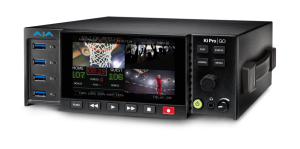NAB 2019 Reflections: AJA’s Bryce Button sees HDR and IP transition topping trends list
AJA Video Systems is one of those NAB exhibitors that always offers up some interesting new products (some as simple as a converter card) that can make a big difference in a production. The company also finds itself at the center of a wide range of users meaning its executives have a chance to glean some of the wider market trends.

AJA’s Bryce Button says HDR was a top theme at NAB this year.
Bryce Button, AJA, director of product marketing, says that HDR-related announcements were received really well across the board from customers.
“At this point in time we are one of the leading companies that take a holistic view of HDR,” says Button. “In the past the conversations were around confusion over how to approach HDR but that has settled down and things like our FS-HDR is a big success. And we have an HDR analyzer that we rolled out at IBC that is becoming a go-to device.”
Also well received was the Ki Pro GO, a genlock-free, multi-channel h.264 HD and SD recorder/player. It can record up to four channels of HD and SD content from SDI and HDMI sources.
“It has found a sweet spot for recording and that is a testament to the rise of OTT services and strong interest from the pro AV markets for live events and integrators serving that market as well as broadcasters.”
For many exhibitors the move to IP was a big theme and Button says that this was the first NAB where he felt there was solid weight behind the transition to IP.
“We were showing the SMPTE ST-2110 transmitter mini-converters which are a very straight-forward IP-to-baseband converter that can allow the user to take a current SDI infrastructure and integrate it with IP,” says Button.

AJA’s Ki Pro GO can record up to four channels of HD and SD via SDI or HDMI sources.
AJA’s efforts with 12G development were also on display as it offered up Corvid 44 12G, an I/O card that supports 12G SDI.
“We started on that path a few years ago and accelerated in the past 18 months,” he says. “For point-to-point needs, especially in sports where 4K is being looked at more seriously as a means of capture, it simplifies the production process.”
Desktop side cross platform support for ProRes, answered a bunch of user headaches, excitement around integration of UnReal engine, integration in games themselves, virtual set stuff exciting, smaller budgets and put together a fairly track with video and IO cards and expanded number of cards accepted by UnReal engine, fun to see and a lot of feedback, live events, somewhat sports, custom size display at venues, can create interesting looking background
Button believes that a world where IP and SDI co-exist will be around for some time so the single-cable simplicity of 12G will be important, even if it simply feeds a source delivered via 12G into an IP switch environment.
“The cost of IP at higher bandwidths has been a headache and it is still an expensive exercise,” he says. “And there is also a natural need for engineers to overcome muscle memory as there is a traditional baseband culture that is nervous about IP.”
Getting the IP and baseband worlds to meet and Button says developments like NMOS, and auto-discovery of IP-connected devices are making a difference.
“Another interesting trend at NAB to keep an eye on is machine learning and AI,” he says. “It will be interesting to see how quickly AI implementations become pragmatic and start to gain more attention.”
